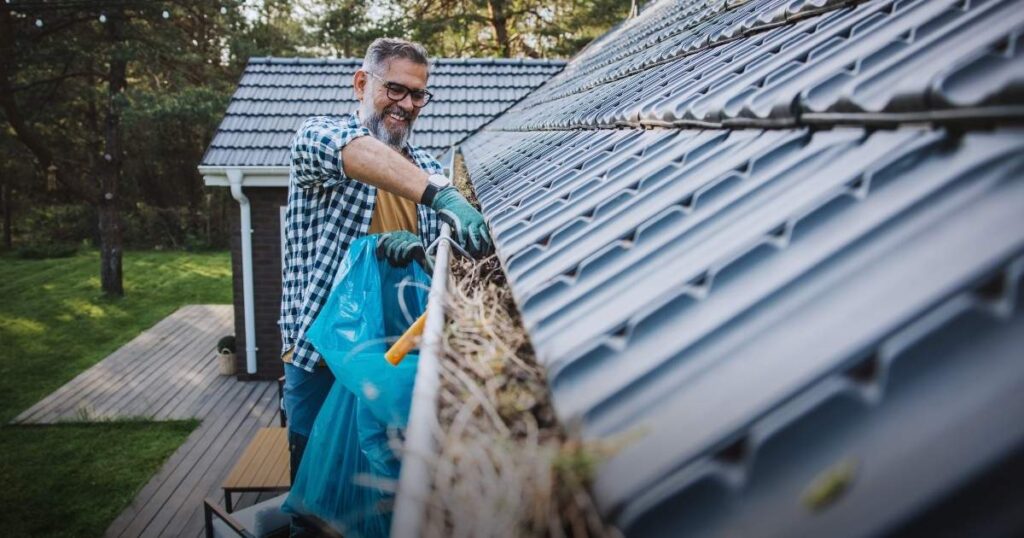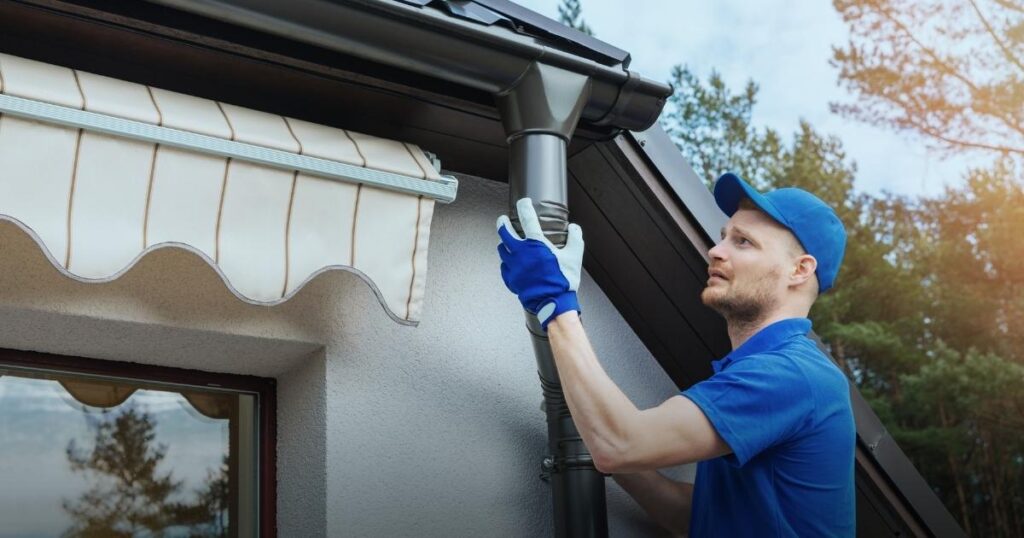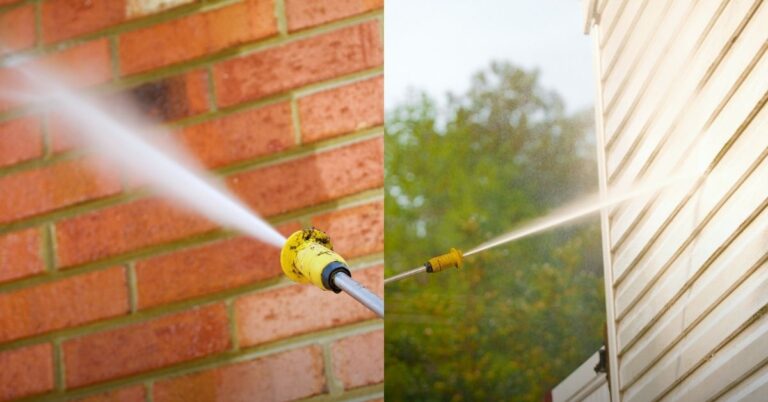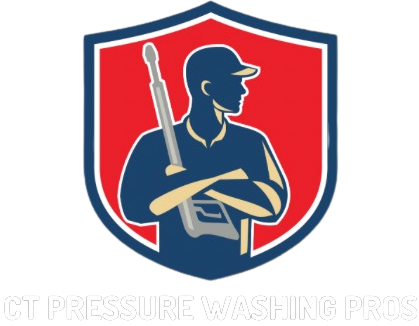Gutters might not be the most exciting part of homeownership, but they do a big job—keeping rainwater away from your foundation, roof, and walls. When they’re clogged with leaves, dirt, and debris, water overflows, leading to costly damage like mold, erosion, and even basement flooding.
Most homeowners grab a ladder, but climbing up to scoop out soggy leaves isn’t just tiring—it’s dangerous. A simple slip could turn a routine task into a trip to the emergency room. That’s why cleaning gutters from the ground is a smarter, safer choice.
With the right tools, you can clear out leaves, twigs, and gunk without ever leaving the ground. Whether you’re using a gutter vacuum, a high-powered blower, or a telescopic wand, this method saves time, effort, and risk. In this guide, we’ll walk through the best tools, step-by-step cleaning techniques, and tips to keep your gutters flowing year-round. Let’s get started.
Table of Contents
Why Cleaning Gutters From the Ground is a Smart Choice
Gutter cleaning is a must if you want to protect your home from water damage, mold, and foundation issues. But how you clean them matters. Most people assume using a ladder is the only way, but that can be risky, exhausting, and unnecessary. Let’s break down why cleaning from the ground is the better option.
The Dangers of Cleaning Gutters With a Ladder
- High Risk of Falls – Climbing a ladder while juggling tools and debris is an accident waiting to happen. A slip, wobble, or gust of wind can send you straight to the ground. Falls from ladders lead to thousands of ER visits every year.
- Unstable Surfaces Make It Worse – Most homes aren’t built on flat ground. Whether it’s a sloped driveway or soft soil, an uneven base makes a ladder even riskier. Even a slight shift can throw off your balance.
- Time-Consuming Process – Cleaning a few feet at a time, climbing down, moving the ladder, and repeating the process takes forever. By the time you’re done, hours have passed, and you’re exhausted.
- Physically Straining – Repeatedly climbing and reaching wear out your legs, back, and shoulders. Handling wet leaves and sludge only adds to the struggle, turning a simple task into a full-body workout.
- Limited Reach – Even on a tall ladder, you can only clean small sections at a time. If your gutters are two or three stories high, you’re out of luck unless you’re willing to take even greater risks.
Benefits of Ground-Based Gutter Cleaning
- No Risk of Falling – The safest way to avoid falling? Stay on the ground. Ground-based tools eliminate ladder risks, making the job safer for everyone.
- Faster and More Efficient – With the right tools, you can walk along your yard and clear gutters in a fraction of the time. No more climbing up and down or adjusting a ladder every few feet.
- Less Physical Strain – Instead of exhausting yourself, let the tools do the work. Whether you use a vacuum, blower, or telescopic wand, cleaning is easier and less tiring.
- Anyone Can Do It – If you’re older, have mobility concerns, or simply don’t like heights, ground-based cleaning is the perfect solution. No need for special skills or climbing experience.
- Better Coverage – With long-reach tools, you can clean more gutter space at once, even on multi-story homes. Some attachments even allow you to see inside the gutters while you clean, ensuring nothing is missed.
Now that you know why ground cleaning is the smarter choice, let’s go over the best tools and techniques to get the job done right.
Step-By-Step Guide to Cleaning Gutters From the Ground
Cleaning your gutters from the ground is easier, safer, and faster when you have the right approach. Instead of struggling with ladders and scooping out soggy leaves by hand, you can use specialized tools to clear your gutters efficiently. Follow these five simple steps to get the job done right.

Step 1: Gather Your Tools & Safety Gear
Before starting, make sure you have everything you need. The right tools will make the job quicker and less messy.
✅ Gutter Cleaning Tools (choose based on what works best for you):
- Gutter vacuum system – Sucks out wet and dry debris.
- Leaf blower with a gutter attachment – Blows out dry leaves and dirt.
- Telescopic wand with a pressure nozzle – Uses water pressure to flush gutters.
- Gutter scoop with an extension pole – Scrapes out debris manually.
✅ Safety Gear:
- Gloves – Keep your hands clean and protected.
- Eye protection – Prevents dust, dirt, and water from getting in your eyes.
- Waterproof clothing or an apron – Helps keep you dry if using a pressure washer.
Now that you’re ready, let’s get to work.
Step 2: Remove Loose Leaves & Debris
Start by getting rid of dry leaves, twigs, and other loose debris before tackling the tough stuff. A leaf blower with a gutter attachment works best for this, blowing everything out in one go. If you don’t have one, a vacuum system with a long hose can also do the job.
Move steadily along the gutter line, making sure to clear out as much as possible. If some debris remains stuck, don’t worry—we’ll handle that in the next step.
Step 3: Clear Out Clogged & Stubborn Debris
If your gutters have wet leaves, dirt buildup, or compacted debris, you’ll need more power. A gutter vacuum is the easiest way to suck everything out, while a telescopic scoop helps if you prefer a hands-on approach.
For sections that won’t budge, a high-pressure wand attachment on a hose or pressure washer can break up the mess. Work in small sections, checking to make sure the water is pushing the debris out instead of packing it in tighter.
Step 4: Flush Gutters & Downspouts
Once the bulk of the debris is gone, it’s time to rinse everything out. A garden hose with a spray nozzle or a telescopic wand is perfect for this step. Start at one end and work your way to the downspouts, ensuring the water flows freely.
If water isn’t draining properly, your downspouts might be clogged. Use a pressure washer attachment or a plumber’s snake to clear any blockages. Make sure water runs smoothly through the entire system before moving on.
Step 5: Dispose of Debris & Inspect for Damage
Don’t leave the mess behind—collect the debris and properly dispose of it in yard waste bags or a compost bin. Then, take a quick walk around your home and check for any gutter issues. Look for sagging sections, leaks, or cracks. If you notice damage, fix it now before it leads to bigger problems.
Now that your gutters are clean, your home is safe from water damage, and you didn’t have to risk a fall. Want to keep your gutters clear longer? Let’s go over a few simple maintenance tips next.
How to Keep Gutters Clean Longer: 5 Simple Maintenance Tips
Cleaning your gutters is one thing—keeping them clean is another. A few simple habits can help you go longer between cleanings and prevent clogs before they start. Let me explain how you can make your next gutter cleaning job easier with these five easy maintenance tips.
1. Install Gutter Guards to Block Debris
Gutter guards act like a filter, stopping leaves, twigs, and dirt from piling up inside your gutters. There are different types—mesh screens, brush inserts, and solid covers—but they all work to keep junk out while letting water flow through. They won’t make your gutters completely maintenance-free, but they’ll cut down on how often you need to clean them.
2. Trim Overhanging Branches to Reduce Debris
Trees dropping leaves, seeds, and small branches into your gutters is one of the biggest causes of clogs. If you have trees near your home, trimming back overhanging branches can make a huge difference. Less debris means less buildup, fewer clogs, and an easier time cleaning when you do need to.
3. Check & Clean Your Gutters Seasonally
Even with the best preventative steps, some dirt and debris will still find their way in. A good rule of thumb is to check and clean your gutters at least twice a year—once in the spring and again in the fall. If you live in an area with lots of trees, you might need to do it more often. Keeping up with regular maintenance prevents big problems like water damage, leaks, and sagging gutters.
4. Ensure Downspouts Stay Clear
Clogged downspouts can make even clean gutters overflow. After every cleaning, run water through the downspouts to make sure they’re draining properly. If water isn’t flowing, use a pressure washer attachment, a plumber’s snake, or even a long stick to break up the clog. A small blockage today can turn into a big problem later, so it’s worth checking.
5. Fix Gutter Damage Before It Gets Worse
Small cracks, loose fasteners, and sagging sections might not seem like a big deal at first, but they can quickly lead to leaks, flooding, and expensive repairs. Every time you clean, take a few minutes to inspect your gutters for damage. Tighten screws, reseal leaks, and make small fixes now to avoid major headaches later.
Taking these simple steps will keep your gutters flowing smoothly and reduce how often you need to clean them. Now that your gutters are in top shape, let’s talk about when it might be time to call in a professional.
When to Call a Professional for Gutter Cleaning
Cleaning gutters from the ground is easier and safer, but sometimes, DIY just isn’t enough. If your gutters are clogged beyond what basic tools can handle, damaged from years of buildup, or simply too high to reach, it might be time to bring in the pros. Here’s how to know when you should make that call.

1. Water Isn’t Draining Properly Even After Cleaning
If you’ve removed the leaves and debris but water still pools in your gutters or spills over the edges, something’s wrong. It could be a hidden clog deep inside the downspout or a slope issue preventing proper drainage. Professionals have the tools to clear stubborn blockages and realign gutters so water flows like it should.
2. Your Gutters Are Overflowing During Rainstorms
Gutters should handle heavy rain with no problem. If yours overflows every time it rains, even after cleaning, you might have a serious clog, a design flaw, or an issue with your home’s drainage system. A pro can figure out the cause and fix it before it leads to water damage, leaks, or foundation issues.
3. You Spot Signs of Damage or Wear
Cracks, rust spots, sagging sections, or gutters pulling away from the house aren’t just cosmetic issues. They can lead to leaks, structural damage, and costly repairs. If you notice sections that look weak or broken, a professional can assess whether they need a simple fix or a full replacement.
4. You Don’t Have the Right Tools or Access
Some homes have high or awkwardly placed gutters that basic ground-level tools can’t reach. If you have a multi-story house or gutters blocked by landscaping, a professional service with high-reach equipment can get the job done without you risking a fall or struggling with makeshift solutions.
5. You’d Rather Save Time & Effort
Let’s be honest—gutter cleaning isn’t anyone’s favorite chore. If you’d rather skip the hassle, hiring a professional is an easy way to get the job done without lifting a finger. It’s a small investment that saves you time, keeps your home protected, and ensures your gutters are cleaned thoroughly.
If any of these signs sound familiar, it’s worth calling in an expert.
Conclusion
Gutter cleaning might not be exciting, but it’s one of those small tasks that can save you from big, expensive problems. Keeping them clear isn’t just about avoiding clogs—it’s about protecting your home from water damage, mold, and structural issues.
The good news? You don’t have to risk climbing a ladder or spend hours struggling with stubborn debris. With the right tools and a few smart maintenance habits, you can keep your gutters clean, your water flowing, and your home safe—all without leaving the ground.
Think of it this way: a little effort now saves you from major headaches later. Whether you do it yourself or hire a pro when needed, making gutter care part of your routine will keep your home in great shape for years to come.





